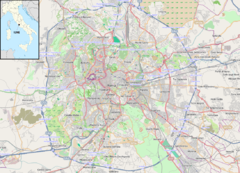Roma San Pietro railway station
|
Roma San Pietro
|
|
|---|---|

The station platforms.
|
|
| Location | Piazza della Stazione di San Pietro 00165 Roma RM Rome, Rome, Lazio Italy |
| Coordinates | 41°53′47″N 12°27′16″E / 41.89639°N 12.45444°ECoordinates: 41°53′47″N 12°27′16″E / 41.89639°N 12.45444°E |
| Operated by | Rete Ferroviaria Italiana |
| Line(s) |
Pisa–Livorno–Roma Roma–Capranica–Viterbo Roma–Città del Vaticano |
| Distance | 11.542 km (7.172 mi) from Roma Termini |
| Platforms | 5 |
| Train operators | Trenitalia |
| Connections |
|
| Other information | |
| Classification | Gold |
| History | |
| Opened | 29 April 1894 |
| Location | |
Roma San Pietro railway station (Italian: Stazione di Roma San Pietro) is a major station serving the city and comune of Rome, Italy. Opened in 1894, the station forms part of the Pisa–Livorno–Rome railway and the Rome–Capranica–Viterbo railway. It is also the junction for the short, single track Rome–Vatican City railway, which crosses into Vatican City after passing over a viaduct.
The station is currently managed by Rete Ferroviaria Italiana (RFI). Train services are operated by Trenitalia. Each of these companies is a subsidiary of Ferrovie dello Stato (FS), Italy's state-owned rail company.
Roma San Pietro railway station is situated at Piazza della Stazione di San Pietro, west of the city centre, and a short distance to the south of Vatican City; the station owes its name to its proximity to St. Peter's Basilica in the Vatican (just 300 m (980 ft) away).
Opened along the line to Viterbo on 29 April 1894, the station, before structural changes to its "country station" features, was one of the favourite locations of the world of cinema. Many of the greatest actors and directors shot a scene in the station or in the forecourt, including Totò, Sordi, Virna Lisi, Buzzanca and many others extending back to the black and white era of film.
At that time, the station consisted of two through tracks passing a small passenger building. Although the station was then situated on a secondary line, the passenger traffic, consisting largely of pilgrims, was notable.
...
Wikipedia

